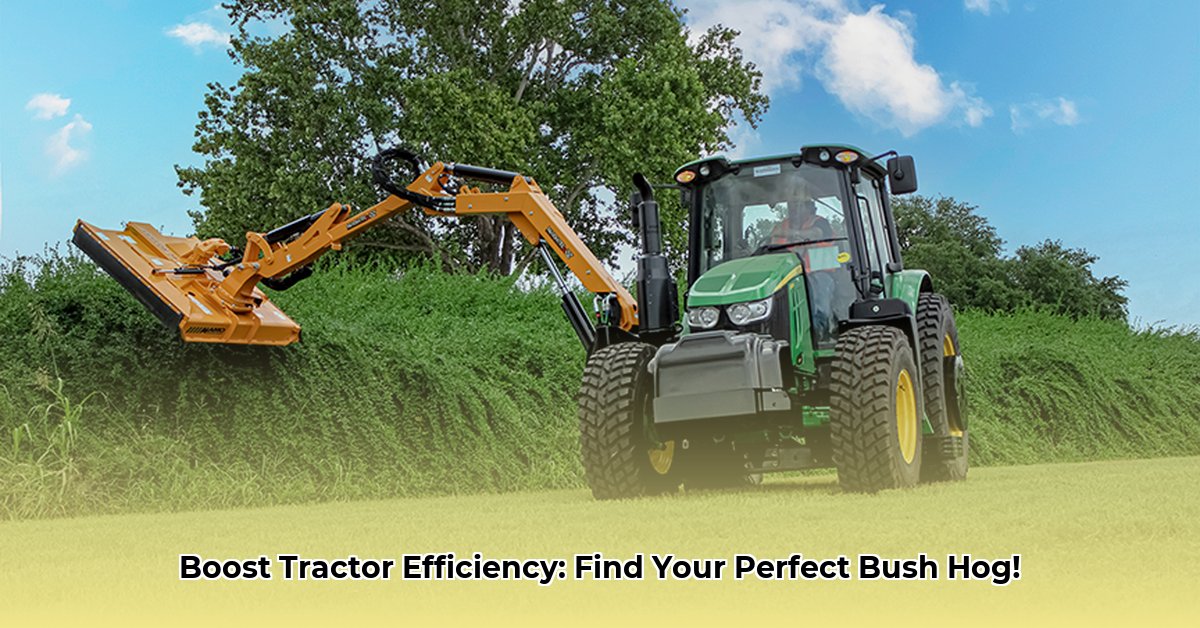
Choosing the Right Side Bush Hog: A Comprehensive Guide
Selecting the right side bush hog for your tractor is crucial for efficient and safe land management. This guide provides a step-by-step process to help you find the perfect match for your specific needs and maximize your productivity. We'll cover everything from assessing your land to understanding horsepower matching and choosing the right attachments. Need to rent a bush hog? Check out tractor rentals.
Understanding Your Land and Needs
Before you begin shopping, thoroughly assess your land and its characteristics. This will inform the type and size of bush hog you need. Consider the following:
- Vegetation Type: Are you dealing with short grass, thick weeds, or tough brush? Denser vegetation requires a more powerful cutter.
- Terrain: Flat fields require different equipment than steep hillsides or rocky terrain. Steeper slopes may necessitate a smaller, lighter cutter for safety.
- Property Size: The size of your property directly affects the cutting width you'll need. Larger properties benefit from wider cutters for increased efficiency.
- Frequency of Use: How often will you use the bush hog? If you only need it occasionally, a smaller, less expensive model might suffice. Frequent use requires durability and reliability.
Matching Horsepower: The Key to Success
Matching your tractor's horsepower to your bush hog is paramount for safe and efficient operation. Underpowering leads to strain, reduced efficiency, and potential damage to both the tractor and the cutter. Overpowering, while seemingly a benefit, is wasteful and unnecessary.
Here's a general guideline:
| Tractor Horsepower Range | Recommended Cutter Width (ft) | Notes |
|---|---|---|
| Under 40 HP | 4-5 | Suitable for light-duty clearing and smaller properties. |
| 40-60 HP | 5-6 | Ideal for moderately dense vegetation and average-sized properties. |
| Over 60 HP | 6-7+ | Handles heavier brush, rough terrain, and larger properties. |
Important: These are rough estimates. Always consult your tractor's manual and the bush hog manufacturer's specifications for precise horsepower recommendations.
Choosing the Right Cutter Width: Balancing Speed and Power
The cutter width significantly impacts productivity. A wider cutter covers more ground per pass, increasing efficiency. However, a wider cutter requires more horsepower. Finding the right balance is key. A small cutter on a powerful tractor is inefficient; a large cutter on a weak tractor is dangerous.
Beyond Horsepower: Essential Considerations
Horsepower is only one piece of the puzzle. Consider these additional crucial factors:
- PTO (Power Take-Off) Shaft: Ensure compatibility between your tractor's PTO and the bush hog's specifications. This is the power transfer mechanism.
- Hydraulics: Many side bush hogs utilize hydraulics for lifting and tilting. Check your tractor's hydraulic system capacity.
- Three-Point Hitch: The three-point hitch is how the cutter attaches to your tractor. Verify complete compatibility.
- Safety Features: Prioritize safety features like shields, deflectors, and safety switches. Your safety is paramount.
Bush Hog Model Comparison (Illustrative Example)
The following table is for illustrative purposes only. Always consult the Bush Hog website and dealer for the most updated models and specifications.
| Model | Cutting Width (ft) | Recommended HP Range | Ideal Application |
|---|---|---|---|
| Model X | 5 | 30-40 | Light brush, grass |
| Model Y | 6 | 40-60 | Moderate brush and weeds |
| Model Z | 7 | 60+ | Heavy brush, rough terrain |
Installing and Using Your Side Bush Hog: A Step-by-Step Guide
- Read the Manuals: Thoroughly review both your tractor's and the bush hog's manuals before operation.
- Prepare Your Tractor: Engage the PTO and check hydraulic fluid levels. Consider adding front-end weights for extra stability, especially with larger cutters on smaller tractors.
- Attach the Cutter: Securely attach the bush hog to the tractor's three-point hitch, following the manufacturer's instructions precisely.
- Adjust Cutting Height: Set the cutting height appropriately for the terrain and vegetation type.
- Test Run: Begin slowly and gradually increase speed as you become comfortable. Always prioritize safety.
- Regular Maintenance: Regular inspection and maintenance are crucial for longevity and safe operation.
Safety First: Always wear appropriate safety gear, including eye protection, hearing protection, sturdy footwear, and gloves. Be mindful of your surroundings while operating heavy machinery.
Key Takeaways: Choosing the Right Bush Hog
- Matching horsepower is crucial for efficient and safe operation.
- Consider vegetation type and terrain when selecting your cutter.
- Evaluate essential features like cutting width, deck design, and safety mechanisms.
- Prioritize safety throughout the entire process.
- Factor in long-term costs, including maintenance and potential repairs.
For more information and to find a local dealer, visit the Bush Hog website: Bush Hog Website